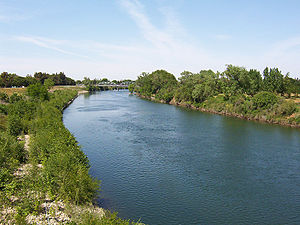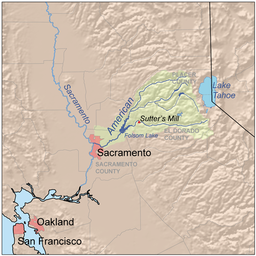- American River
-
For other uses, see American River (disambiguation).
American River River American River view from the campus of California State University, SacramentoCountry United States State California Region Sacramento Valley Part of Sacramento River watershed Tributaries - left South Fork American River - right North Fork American River City Sacramento Primary source North Fork American River - location Mountain Meadow Lake, Placer County - elevation 7,923 ft (2,415 m) [1] - coordinates 39°13′04″N 120°16′28″W / 39.21778°N 120.27444°W [2] Secondary source South Fork American River - location Nebelhorn, El Dorado County - elevation 7,401 ft (2,256 m) [3] - coordinates 38°48′38″N 120°01′52″W / 38.81056°N 120.03111°W [4] Source confluence Folsom Lake - location Near Folsom - elevation 253 ft (77 m) - coordinates 38°29′28″N 121°09′24″W / 38.49111°N 121.15667°W [5] Mouth Sacramento River - location Sacramento - elevation 23 ft (7 m) [5] - coordinates 38°35′51″N 121°30′29″W / 38.5975°N 121.50806°W [5] Length 119 mi (192 km), Northeast-southwest Main stem 31 miles (50 km); North Fork 88 miles (142 km)[6] Basin 2,150 sq mi (5,568 km2) [7] Discharge for Fair Oaks - average 3,685 cu ft/s (104 m3/s) [8] - max 314,000 cu ft/s (8,891 m3/s) [8] - min 215 cu ft/s (6 m3/s) [8] Map of the American River watershed. It includes the North, Middle, and South forks of the river as well as Rubicon River, a tributary of the Middle Fork.The American River (Río de los Americanos during the Mexican-ruled period before 1846) is a California watercourse noted as the site of Sutter's Mill, northwest of Placerville, California, where gold was found in 1848, leading to the California Gold Rush. This river runs from the Sierra Nevada mountain range, through the Sacramento metropolitan area, where it enters into the Sacramento River on its way to the San Francisco Bay. Today the American River is known for its whitewater rapids.
Contents
Course
The American River is divided into the North, Middle, and South forks that contain recreational havens for well over one million visitors per year in El Dorado County, Placer County, and Sacramento County in the Sierra Nevada mountain range of northern California. The river originates in the Tahoe and Eldorado National Forests.[9] From the confluence at Auburn, the combined North and Middle Forks river flows at an elevation of 600 feet (180 m) in a forested canyon 800 feet (240 m) deep and is called the North Fork. It meanders through additional wilderness recreational canyons past the site of the abandoned Auburn Dam, and back into wilderness, onward to where it meets the South Fork at Folsom Lake. All three forks are known for their verdant canyons, forested ridges, massive rock formations, trails, backcountry winter adventuring among snowy peaks, fishing and white water rafting.
Below Folsom Lake, the river passes through an urbanized area but is buffered by a riparian park, the American River Parkway. Containing fishing and family-oriented rafting, and paved bicycling and multi-use trails, it runs 30.6 miles (49.2 km)[6] from Folsom Lake to the river's confluence with the Sacramento River. The American River Parkway incorporates Historic Leidesdorff Ranch, a 35,000-acre (140 km2) cattle and wheat agribusiness owned by the "African Founding Father of California." Jedediah Smith Memorial Trail, a meandering, uninterrupted 32-mile (51 km) cycle path, hugs the river bank from Old Sacramento to Folsom Lake.
North Fork
The North Fork is the longest tributary of the American River, at 88 miles (142 km).[6] It begins at an elevation of 7,089 feet (2,161 m) near Lake Tahoe in Placer County at the snowcapped crest of the Sierras. The North Fork originates at or near Mountain Meadow Lake, just northeast of Granite Chief and immediately due west of Squaw Valley Ski Resort. It flows westward through remote wilderness areas. The North Fork and its tributaries provides one of the most biologically diverse habitats in North America. The North Fork features scenic multi-use trails along forested ridgetops and riparian corridors. It flows freely as a federally eligible National Wild and Scenic Rivers System river until a small debris dam, Clementine, immediately north of the Foresthill Bridge and prior to the confluence with the Middle Fork at Auburn, California. Both the North Fork and Middle Fork feature archaeological and historic sites of ancient American Indian culture and 1850s Gold Rush habitation.
Middle Fork
The 62-mile-long (100 km)[6] Middle Fork originates near the source of the North Fork but on the south face of Granite Chief, between the summit and Emigrant Pass. It is characterized by somewhat broader steep canyons interspersed with manmade reservoirs, natural waterfalls, and quiet riparian areas. The Middle Fork is used extensively for both motorized and non-motorized recreation, including fishing, white water adventuring, bicycling (mountain and road), horseback riding, trail running and hiking. It contains areas used for hydroelectric generation, mining, and agricultural timber cultivation and harvesting. The Middle Fork features the Western States Trail, which hosts multiple annual endurance events, including the prestigious Tevis Cup equestrian trail ride and the world-famous Western States 100- Mile Trail Run, both beginning at Squaw Valley and leading to Auburn via remote wilderness trails.
South Fork
The 87-mile-long (140 km)[6] South Fork originates at Echo Summit near Echo Lake south of Lake Tahoe in El Dorado County, just south of where U.S. Route 50 makes a sharp curve northward to descend into Tahoe Valley. The South Fork has multi-use recreational areas, including the Rubicon Trail for motorized adventuring and whitewater rafting venues. The South Fork also features Coloma, the site where gold was discovered in California in 1848. Trout fishing and recreational gold panning are popular family activities.
The Silver Fork American River is a 20-mile-long (32 km)[6] tributary of the South Fork American River (confluence at 38°46′03″N 120°18′57″W / 38.767636°N 120.315828°W) that begins within the west Sierra slope (38°36′51″N 120°07′13″W / 38.614188°N 120.120263°W) and has a branch (Caples Creek) that drains from Winemucca Lake and the Sierra Crest (38°39′50″N 119°59′08″W / 38.663933°N 119.985595°W). The American River's section of the Sierra Crest extends ~50 mi (80 km) between the north triple watershed point (South Yuba, North Fork American, and Truckee rivers) at Mount Lincoln (39°17′16″N 120°19′41″W / 39.28778°N 120.32806°W) to the Winemucca Lake triple point (Sacramento, San Joaquin, and central Lahontan hydrologic subregions).
Like most major western U.S. rivers, the American River has been extensively dammed and diverted for hydroelectricity production. Bunch Creek is one of the tributaries of the North Fork of the American River. Since the California Gold Rush was centered along the American River basin, it was one of the earlier California rivers to be populated, beginning at Leidesdorff Ranch, owned by William Leidesdorff. Water was used to drive grist mills. By the end of the 19th century, some of these mill sites were converted to the earliest hydroelectric plants, with Folsom State Prison's using the river to generate electricity in 1893. The Natoma Company completed its Folsom Powerhouse by 1895 and began delivering power 22 miles (35 km) away to the city of Sacramento.
Today, five power plants on the Middle Fork are owned by the Placer County Water Agency. On the South Fork, SMUD owns eight plants, El Dorado Irrigation District and PG&E each own one plant (Akin Powerhouse and Chili Bar Powerhouse, respectively), and the eleventh plant is owned by a small private concern (Rock Creek Powerhouse). The SMUD plants are run on a peaking basis, although recreational boating and environmental flow requirements constrain their operation slightly. None of these upstream plants are constrained by flood control requirements plants on the upstream tributaries, the needs of water supply and flood control largely govern their operation.
See also
- Cardwell v. American Bridge Co.
- List of California rivers
References
- ^ "Mountain Meadow Lake". Geographic Names Information System, U.S. Geological Survey. 1981-01-19. http://geonames.usgs.gov/pls/gnispublic/f?p=gnispq:3:::NO::P3_FID:263903. Retrieved 2010-09-26.
- ^ "North Fork American River". Geographic Names Information System, U.S. Geological Survey. 1981-01-19. http://geonames.usgs.gov/pls/gnispublic/f?p=gnispq:3:::NO::P3_FID:267066. Retrieved 2010-09-26.
- ^ "Nebelhorn". Geographic Names Information System, U.S. Geological Survey. 1981-01-19. http://geonames.usgs.gov/pls/gnispublic/f?p=gnispq:3:::NO::P3_FID:1656186. Retrieved 2010-09-26.
- ^ "South Fork American River". Geographic Names Information System, U.S. Geological Survey. 1981-01-19. http://geonames.usgs.gov/pls/gnispublic/f?p=gnispq:3:::NO::P3_FID:1654958. Retrieved 2010-09-26.
- ^ a b c "American River". Geographic Names Information System, U.S. Geological Survey. 1981-01-19. http://geonames.usgs.gov/pls/gnispublic/f?p=gnispq:3:::NO::P3_FID:254562. Retrieved 2010-09-26.
- ^ a b c d e f U.S. Geological Survey. National Hydrography Dataset high-resolution flowline data. The National Map, accessed March 10, 2011
- ^ "Boundary Descriptions and Names of Regions, Subregions, Accounting Units and Cataloging Units". U.S. Geological Survey. http://water.usgs.gov/GIS/huc_name.html. Retrieved 2010-08-22.
- ^ a b c "USGS Gage #11446500 on the American River at Fair Oaks, CA" (PDF). National Water Information System. United States Geological Survey. 1905-present. http://wdr.water.usgs.gov/wy2009/pdfs/11446500.2009.pdf. Retrieved 2010-09-26.
- ^ "The American River: California's Favorite Whitewater River". TheAmericanRiver.com. http://www.theamericanriver.com/. Retrieved 2010-08-06.
- Sutter's Mill, aka Marshall Gold Discovery State Historic Park
- Folsom Dam
- Nimbus Dam
- American River Parkway (Sacramento County)
- Guide to Rafting and Kayaking on the American River
- U.S. Geological Survey Geographic Names Information System: American River
Sacramento River Valley Pit River • McCloud River • Mill Creek • Deer Creek • Battle Creek •Stony Creek •Butte Creek • Feather River • Yuba River • Bear River • American River • Cache Creek • Putah CreekSan Joaquin River Valley Tulare Basin Central Valley Project Infrastructure Dams Auburn Dam · B.F. Sisk Dam · Folsom Dam · Friant Dam · Lewiston Dam · New Melones Dam · Nimbus Dam · O'Neill Dam · Red Bluff Diversion Dam · San Justo Dam · Shasta Dam · Sly Park Dam · Spring Creek Dam · Sugar Pine Dam · Trinity Dam · Whiskeytown Dam
Reservoirs Folsom Lake · Millerton Lake · Lake Natoma · New Melones Lake · O'Neill Forebay · San Luis Reservoir · Sugar Pine Reservoir · Shasta Lake · Trinity Lake · Whiskeytown Lake
Aqueducts and canals Clear Creek Tunnel · Contra Costa Canal · Corning Canal · Delta Cross Channel · Delta–Mendota Canal · Friant-Kern Canal · Madera Canal · San Luis Canal · Tehama-Colusa Canal
Rivers American River · Clear Creek · Chowchilla River · Kern River · Sacramento River · San Joaquin River · San Luis Creek · Stanislaus River
Coordinates: 38°35′51″N 121°30′29″W / 38.5975°N 121.50806°W
Categories:- California Gold Rush
- Wild and Scenic Rivers of the United States
- Central Valley of California
- Rivers of El Dorado County, California
- Rivers of Placer County, California
- Rivers of Sacramento County, California
- Sierra Nevada (U.S.)
- Tributaries of the Sacramento River
Wikimedia Foundation. 2010.


